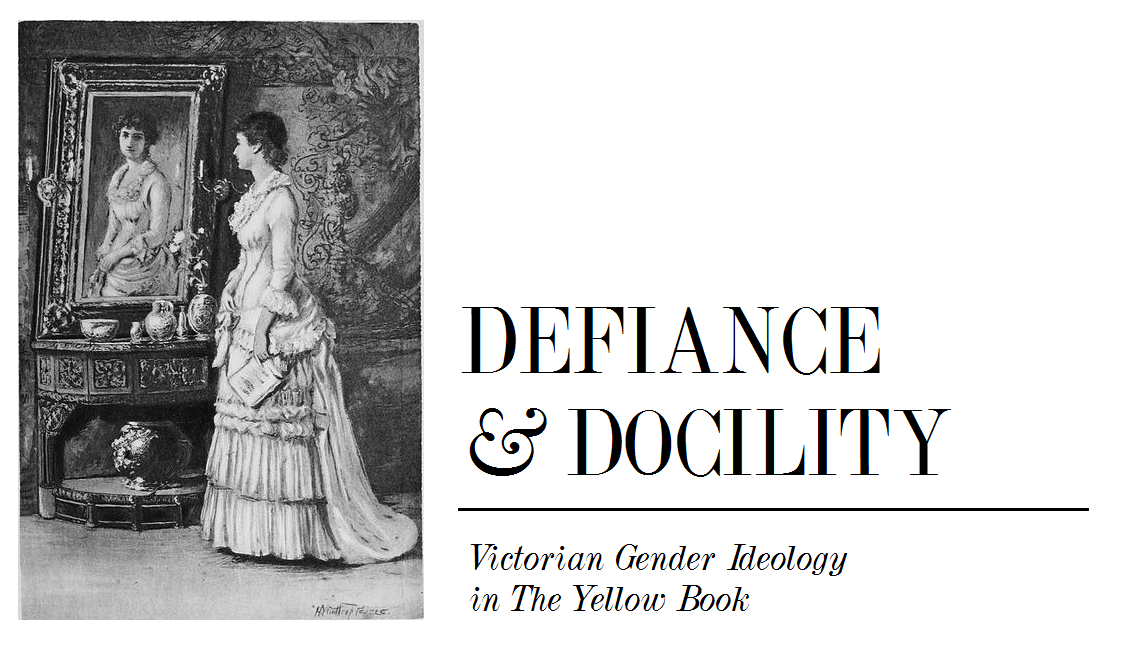Defiance & Docility: Victorian Gender Ideology in The Yellow Book
Vicki Lee
Ryerson University
2357

|
Image Above: "Works (1895)".

|
ABOUT THE YELLOW BOOK
The Yellow Book made its reputation with its avant-garde content and motley group of contributors. The magazine’s patchwork format featured entries contributed by both male and female writers from different countries. The Yellow Book strove to demolish “old traditions of periodical literature” and ushered in an era of “charming” and “daring” publications (Diebel 48). The magazine shattered convention right from its debut, having a prostitute gracing the cover of Volume I (Turner 143). This was one of the many ways that The Yellow Book experimented with evolving attitudes towards femininity. In particular, “Defiance and Docility” will focus on a text from Volume IV, published in January 1895, and image from Volume VI, published in July 1895.
The Yellow Book made its reputation with its avant-garde content and motley group of contributors. The magazine’s patchwork format featured entries contributed by both male and female writers from different countries. The Yellow Book strove to demolish “old traditions of periodical literature” and ushered in an era of “charming” and “daring” publications (Diebel 48). The magazine shattered convention right from its debut, having a prostitute gracing the cover of Volume I (Turner 143). This was one of the many ways that The Yellow Book experimented with evolving attitudes towards femininity. In particular, “Defiance and Docility” will focus on a text from Volume IV, published in January 1895, and image from Volume VI, published in July 1895.
ABOUT MARION HEPWORTH DIXON'S "A THIEF in the NIGHT"
Marion Hepworth Dixon’s “A Thief in the Night” falls under the genres of fiction, short story, and periodical. Dixon’s piece is about a married woman, Mrs. Rathbourne, who copes with the death of her brother-in-law and paramour. While she stays at his house, Mrs. Rathbourne scavenges through his belongings to assuage her grief. This story encapsulates Dixon's style, as she often wrote about women grappling with the challenges they face in Victorian society. Also, Dixon reviewed stories about the New Woman during her time at the Englishwoman magazine, taking special interest in ones that explored female oppression (Palmer). This story testifies her penchant for the assertive, wayward, and defiant female character who rebelled against the institution of marriage.
Marion Hepworth Dixon’s “A Thief in the Night” falls under the genres of fiction, short story, and periodical. Dixon’s piece is about a married woman, Mrs. Rathbourne, who copes with the death of her brother-in-law and paramour. While she stays at his house, Mrs. Rathbourne scavenges through his belongings to assuage her grief. This story encapsulates Dixon's style, as she often wrote about women grappling with the challenges they face in Victorian society. Also, Dixon reviewed stories about the New Woman during her time at the Englishwoman magazine, taking special interest in ones that explored female oppression (Palmer). This story testifies her penchant for the assertive, wayward, and defiant female character who rebelled against the institution of marriage.
ABOUT WILLIAM STRANG'S "GOING to CHURCH"
William Strang’s “Going to Church” is a visual art piece that was originally an oil painting. It was remediated for publication in The Yellow Book by halftone engraving. The image shows four figures en route to church, as suggested by the title. A man holding a book leads three other people, who are lagging several paces behind. Immediately following this man are a cloaked woman and a girl. The woman’s head is lowered towards the ground and her hands are folded in front of her. Beside her, the girl leaves her head uncovered and fixes her eyes straight ahead. The last figure’s visage is obscured by the shade from a tree, showing only his left hand extended to grasp the trunk. A prolific artist, “Going to Church” is one of the many paintings that showcase Strang’s realist approach to his work. It shows characters suspended in the middle of a commonplace event, the hallmark of Strang’s paintings (Tate London).
William Strang’s “Going to Church” is a visual art piece that was originally an oil painting. It was remediated for publication in The Yellow Book by halftone engraving. The image shows four figures en route to church, as suggested by the title. A man holding a book leads three other people, who are lagging several paces behind. Immediately following this man are a cloaked woman and a girl. The woman’s head is lowered towards the ground and her hands are folded in front of her. Beside her, the girl leaves her head uncovered and fixes her eyes straight ahead. The last figure’s visage is obscured by the shade from a tree, showing only his left hand extended to grasp the trunk. A prolific artist, “Going to Church” is one of the many paintings that showcase Strang’s realist approach to his work. It shows characters suspended in the middle of a commonplace event, the hallmark of Strang’s paintings (Tate London).





